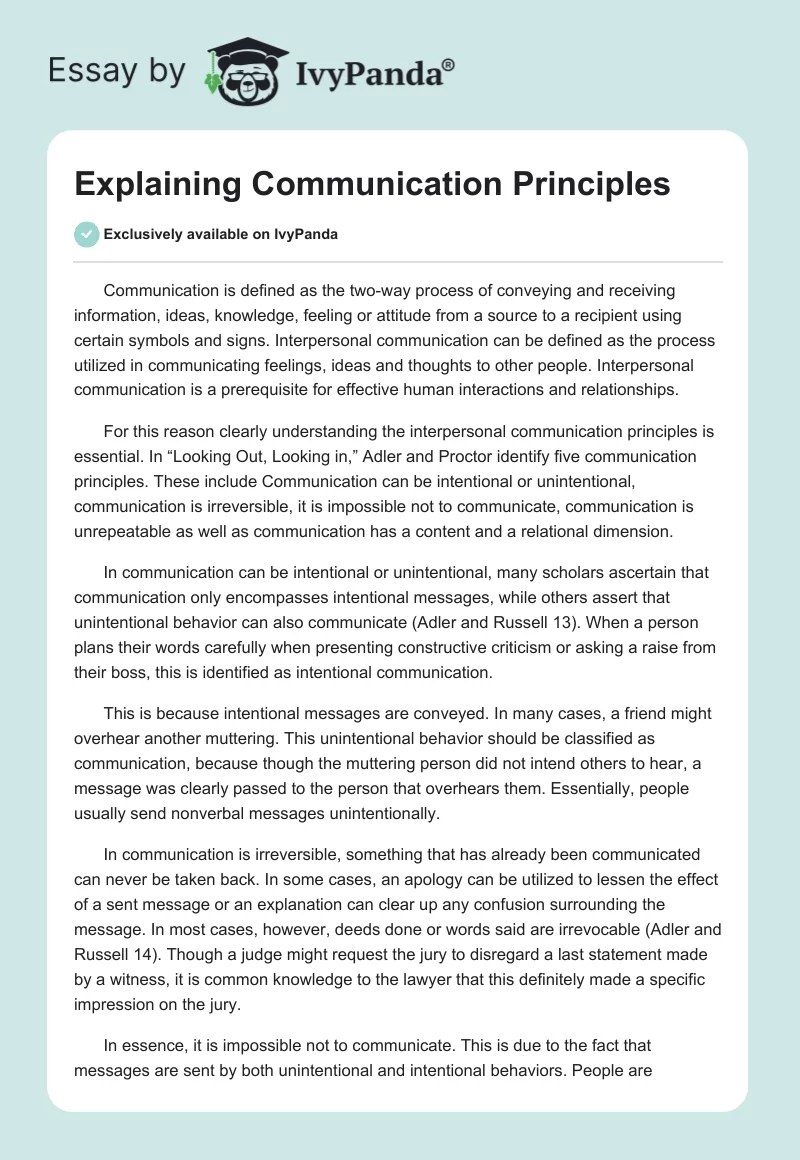Communication is defined as the two-way process of conveying and receiving information, ideas, knowledge, feeling or attitude from a source to a recipient using certain symbols and signs. Interpersonal communication can be defined as the process utilized in communicating feelings, ideas and thoughts to other people. Interpersonal communication is a prerequisite for effective human interactions and relationships.
For this reason clearly understanding the interpersonal communication principles is essential. In “Looking Out, Looking in,” Adler and Proctor identify five communication principles. These include Communication can be intentional or unintentional, communication is irreversible, it is impossible not to communicate, communication is unrepeatable as well as communication has a content and a relational dimension.
In communication can be intentional or unintentional, many scholars ascertain that communication only encompasses intentional messages, while others assert that unintentional behavior can also communicate (Adler and Russell 13). When a person plans their words carefully when presenting constructive criticism or asking a raise from their boss, this is identified as intentional communication.
This is because intentional messages are conveyed. In many cases, a friend might overhear another muttering. This unintentional behavior should be classified as communication, because though the muttering person did not intend others to hear, a message was clearly passed to the person that overhears them. Essentially, people usually send nonverbal messages unintentionally.
In communication is irreversible, something that has already been communicated can never be taken back. In some cases, an apology can be utilized to lessen the effect of a sent message or an explanation can clear up any confusion surrounding the message. In most cases, however, deeds done or words said are irrevocable (Adler and Russell 14). Though a judge might request the jury to disregard a last statement made by a witness, it is common knowledge to the lawyer that this definitely made a specific impression on the jury.
In essence, it is impossible not to communicate. This is due to the fact that messages are sent by both unintentional and intentional behaviors. People are envisioned as transmitters that can never be shut down, because whatever they do provides information about their thoughts and feelings to others (Adler and Russell 14).
The manner in which different people decode the message sent, however, might not be accurate culminating into inaccurate interpretation of the information provided. For example certain information might be branded a joke, while it was intended to be serious.
In many cases, the re-creation of certain events is impossible. This is because the same behaviors and words might convey a different message every time they are used. This ascertains that communication is unrepeatable. The fact that communication encompasses an ongoing process establishes that the repetition of a certain event will never have the same effect (Adler and Russell 14).
For example, a smile that was utilized to appeal to a certain stranger the previous week might not appeal to the same stranger this week. This is because even though the sender and the recipient are the same, the message sent might be interpreted differently.
In communication has a content and relational dimension, the content dimension encompasses the information being conveyed, while the relational dimension identifies the feelings between the information sender and recipient. In some cases the content dimension is more important than the relational dimension.
A good example of this is the disregard people have towards the feelings of the customer service representatives as long as their demands are met (Adler and Russell 15). Essentially, the relational dimension might be more trivial that the content dimension.
Most arguments are based on this because they originate from trivial subjects that result from the feelings between the sender and recipient, of the information conveyed. For example an argument might ensue when two people disagree on whose turn it is to take wash the dishes.
Work Cited
Adler, Ronald B, and Russell F. Proctor. Looking Out/looking in. Australia: Wadsworth/Cengage Learning, 2011. Print.

 4.00
4.00
